Hydro-Economic Water Allocation Model for Water Supply Risk Analysis: A Case Study of Namhan River Basin, South Korea
Abstract
1. Introduction
2. Materials and Methods
2.1. Full-Step Linear Programming (FSLP) in the WAMM
2.2. Economic Valuation of Water Resources in the WAMM
2.3. Climate Change Scenarios
2.3.1. Changes in Water Supply
2.3.2. Changes in Water Demand
3. Case Study
3.1. Application Area (Namhan River Basin, South Korea)
3.2. Economic Value of Water Resources in the Namhan River Basin
3.3. Application of Climate Change Scenario in the Namhan River Basin
3.3.1. River Basin Flow Projection
3.3.2. Water Demand Projection
4. Application Results
4.1. Water Allocation Using SSLP
4.1.1. Reliability-Based Water Allocation Using SSLP
4.1.2. Economy-Based Water Allocation Using SSLP
4.2. Water Allocation Using FSLP
4.2.1. Reliability-Based Water Allocation Using FSLP
4.2.2. Economy-Based Water Allocation Using FSLP
5. Discussion
6. Conclusions
- The results of the reliability-based SSLP allocation show that, according to the considered climate change scenario, the water shortage in June over the next 30 years will be an average and maximum of 9.7 million m3/month and 32.3 million m3/month (2024), respectively, corresponding to average and maximum economic damages of 5.0 billion KRW/month and 16.9 billion KRW/month (2024), respectively.
- The results of the economy-based SSLP allocation show a lower total water shortage because water allocation focused on municipal and industrial sectors and the use of reclaimed water increased; moreover, the priority of river maintenance flow demand was lowered. Over the next 30 years, average and maximum water shortages in June of 6.7 million m3/month and 21.5 million m3/month (2036), respectively, were obtained, corresponding to average and maximum economic damages of 3.8 billion KRW/month and 10.6 billion KRW/month (2024), respectively. Therefore, compared to the reliability-based SSLP method, in which the objective function of water allocation is simply based on the supply quantity, water allocation considering the economic value of the water reduces both the water shortage and economic loss to a certain degree.
- The results of the reliability-based FSLP allocation confirm that the total water shortage was considerably reduced by flexibly utilizing storage facilities to respond to water shortages that are predicted to develop throughout the entire simulation period. The average and maximum water shortages in June were found to be 2.5 million m3/month and 8.3 million m3/month (2024), respectively, corresponding to average and maximum economic damages of 2.03 billion KRW/month and 4.38 billion KRW/month (2024), respectively.
- Economy-based FSLP allocation indicates the same quantity of water shortage as the reliability-based FSLP allocation but preferentially supplies water to municipal/industrial demand sites that comprise a high proportion of industrial water demand. This difference resulted in average and maximum economic damages of 2.02 billion KRW/month and 4.36 billion KRW/month (2024), respectively, over the 30-year period, which are slightly less than the corresponding values obtained using the reliability-based FSLP.
Author Contributions
Funding
Data Availability Statement
Conflicts of Interest
References
- The World Bank. “Water Resources Management.” World Bank 20 September 2017. Available online: www.worldbank.org/en/topic/waterresourcesmanagement#2 (accessed on 7 May 2021).
- UNESCO, UN-Water. United Nations World Water Development Report 2020: Water and Climate Change, Paris, UNESCO. 2020. Available online: http://www.unwater.org/publications/world-water-development-report-2020/ (accessed on 7 May 2021).
- Adetoro, A.A.; Ngidi, M.; Nyam, Y.S.; Orimoloye, I.R. Temporal evaluation of global trends in water footprint, water sustainability and water productivity research. Sci. Africa 2021, 12, e00732. [Google Scholar]
- Strzepek, K.M.; Lenton, R.L. Analysis of Multipurpose River Basin Systems: Guidelines for Simulation Modelling. In Technical Report No. 236 Ralph M. Parsons Laboratory for Water Resources and Hydrodynamics, Department of Civil Engineering; Massachusetts Institute of Technology: Cambridge, MA, USA, 1978. [Google Scholar]
- Strzepek, K.M.; MITSIM-2 a Simulation Model for Planning and Operational Analysis of River Basin Systems. 1981. WP-81-124. Available online: http://pure.iiasa.ac.at/id/eprint/1637/ (accessed on 20 August 2020).
- Shafer, J.; Labadie, J. Synthesis and Calibration of a River Basin Water Management Model. Completion Report No. 89, Colorado Water Resources Research Institute, Colorado State University, Ft. Collins. 1978. Available online: http://former.iemss.org/sites/iemss2006//papers/w5/MODSIMpaper.pdf (accessed on 20 August 2020).
- Andreu, J.; Capilla, J.; Sanchis, E. AQUATOOL: A computer-assisted support system for water resources research management including conjunctive use. In Decision Support Systems. NATO ASI Series (Series G: Ecological Sciences); Loucks, D.P., da Costa, J.R., Eds.; Springer: Berlin/Heidelberg, Germany, 1991; Volume 26, pp. 333–355. [Google Scholar]
- Raskin, P.; Hansen, E.; Zhu, Z.; Stavisky, D. Simulation of water supply and demand in the Aral Sea Basin. Water Int. 1992, 17, 55–67. [Google Scholar] [CrossRef]
- Yates, D.; Sieber, J.; Purkey, D.; Huber-Lee, A. WEAP21—A demand-, priority-, and preference-driven water planning model: Part 1: Model characteristics. Water Int. 2005, 30, 487–500. [Google Scholar] [CrossRef]
- Diaz, G.E.; Brown, T.C.; Sveinsson, O. AQUARIUS: A modeling system for river basin water allocation. General Technical Report RM-GTR-299. In U.S. Department of Agriculture, Forest Service; Rocky Mountain Forest and Range Experiment Station: Fort Collins, CO, USA, 1997. [Google Scholar]
- Choi, S.; Lee, D.; Moon, J.; Kang, S. Application of integrated water resources evaluation and planning system (K-WEAP). J. Korea Water Resour. Assoc. 2010, 43, 625–633. [Google Scholar] [CrossRef][Green Version]
- Zagona, E.A.; Fulp, T.J.; Shane, R.; Magee, T.; Goranflo, H.M. Riverware: A generalized tool for complex reservoir system modeling. J. Am. Water Resour. Assoc. 2001, 37, 913–929. [Google Scholar] [CrossRef]
- Howitt, R.E.; Lund, J.R.; Kirby, K.W.; Jenkins, M.W.; Draper, A.J.; Grimes, P.M.; Ward, K.B.; Davis, M.D.; Newlin, B.D.; van Lienden, B.J.; et al. Integrated Economic-Engineering Analysis of California’s Future Water Supply. Project Completion Report, Department of Civil and Environmental Engineering, University of California, Davis. 1999. Available online: https://www.researchgate.net/profile/Marion_Jenkins/publication/238672816_Integrated_Economic-Engineering_Analysis_of_California’s_Future_Water_Supply/links/54871eba0cf2ef34478eb92e/Integrated-Economic-Engineering-Analysis-of-Californias-Future-Water-Supply.pdf (accessed on 20 August 2020).
- Newlin, B.D.; Jenkins, M.W.; Lund, J.R.; Howitt, R.E. Southern California water markets: Potential and limitations. J. Water Resour. Plan. Manag. 2002, 128, 21–32. [Google Scholar] [CrossRef]
- Pulido-Velazquez, M.; Jenkins, M.W.; Lund, J.R. Economic values for conjunctive use and water banking in southern California. Water Resour. Res. 2004, 40. [Google Scholar] [CrossRef]
- Costanza, R.; d’Arge, R.; de Groot, R.; Farber, S.; Grasso, M.; Hannon, B.; Raskin, R.G. The value of the world’s ecosystem services and natural capital. Nature 1997, 387, 253–260. [Google Scholar] [CrossRef]
- De Groot, R.S.; Wilson, M.A.; Boumans, R.M. A typology for the classification, description and valuation of ecosystem functions, goods and services. Ecol. Econ. 2002, 41, 393–408. [Google Scholar] [CrossRef]
- Portela, R.; Bezerra, M.O.; Alam, M.; Shaad, K.; Banerjee, O.; Honzák, M. Discussion Paper 8: Water Supply Services: Biophysical Modeling and Economic Valuation in Ecosystem Accounting. Proceedings of Expert Meeting on Advancing the Measurement of Ecosystem Services for Ecosystem Accounting, New York, NY, USA, 22–24 January 2019; Subsequently Revised. Version of 15 March 2019. Available online: https://seea.un.org/events/expert-meeting-advancing-measurement-ecosystem-services-ecosystem-accounting (accessed on 7 May 2021).
- Hwang, S.; Um, M.; Kim, T. The valuation of the reliability of municipal water supply using contingent valuation method in Korea. Environ. Resour. Econ. Rev. 1999, 8, 109–126. [Google Scholar]
- Park, S.; Ryoo, K.; Kim, J.; Kim, B. The case study of economic value assessment of spring rainfall in the aspect of water resources. J. Environ. Sci. Int. 2014, 23, 193–205. [Google Scholar] [CrossRef][Green Version]
- K-water. Improving Measures of Feasibility Study for Water Resources Projects. Research Report, K-Water. 2008. Available online: https://scienceon.kisti.re.kr/srch/selectPORSrchReport.do?cn=TRKO201800028815 (accessed on 20 August 2020).
- Lim, J.; Lee, M. Marginal benefit-cost analysis of irrigation water in rice production. J. Agric. Sci. Chungnam Nat’l Univ. 2001, 28, 132–146. [Google Scholar]
- KEI (Korea Environment Institute). EVIS (Environment Valuation Information System). Available online: http://evis.kei.re.kr/research (accessed on 20 August 2020).
- Krol, M.; Jaeger, A.; Bronstert, A.; Güntner, A. Integrated modelling of climate, water, soil, agricultural and socioeconomic processes: A general introduction of the methodology and some exemplary results from the semi-arid north-east of Brazil. J. Hydrol. 2006, 328, 417–431. [Google Scholar] [CrossRef]
- Ray, P.A.; Kirshen, P.H.; Watkins, D.W., Jr. Staged climate change adaptation planning for water supply in Amman, Jordan. J. Water Resour. Plan. Manag. 2012, 138, 403–411. [Google Scholar] [CrossRef]
- Ashofteh, P.S.; Haddad, O.B.; Marino, M.A. Risk analysis of water demand for agricultural crops under climate change. J. Hydrol. Eng. 2015, 20, 04014060. [Google Scholar] [CrossRef]
- Liu, Y.; Guo, H.; Zhang, Z.; Wang, L.; Dai, Y.; Fan, Y. An optimization method based on scenario analysis for watershed management under uncertainty. Environ. Manag. 2007, 39, 678–690. [Google Scholar] [CrossRef] [PubMed]
- Basupi, I.; Kapelan, Z. Evaluating flexibility in water distribution system design under future demand uncertainty. J. Infrastruct. Syst. 2015, 21, 04014034. [Google Scholar] [CrossRef]
- Jeong, G.; Choi, S.; Kang, D. Development and application of hydro-economic optimal water allocation and management model. J. Korea Water Resour. Assoc. 2019, 52, 707–718. [Google Scholar]
- MLTM (Ministry of Land, Transport and Maritime Affairs). National Water Resources Plan (2011–2020), Republic of Korea. 2011. Available online: https://www.kwater.or.kr/gov3/sub03/annoView.do?seq=1889&s_mid=54 (accessed on 20 August 2020).
- Cho, J.; Jung, I.; Park, J.; Lee, J. Development of AR5 Representative GCMs Selection Technique and Generation of Downscaled Climate Change Scenarios, 2020, CCAW-TR-01, Climate Change Adaptation for Water Resources, Republic of Korea. Available online: https://drive.google.com/file/d/13RY1wOfh8tTtOaRXP75LU3OzkPYrt7qi/view (accessed on 20 August 2020).
- Collins, W.J.; Bellouin, N.; Doutriaux-Boucher, M.; Gedney, N.; Halloran, P.; Hinton, T.; Martin, G. Development and evaluation of an Earth-System model–HadGEM2. Geosci. Model Dev. Discuss 2011, 4, 997–1062. [Google Scholar]
- Duda, P.; Kittle, J., Jr.; Gray, M.; Hummel, P.; Dusenbury, R.; Decatur, G.; Kinerson, R. An Interactive Windows Interface to HSPF (WinHSPF). In User’s Manual, AQUA TERRA Consultants, 2001. Available online: https://textarchive.ru/c-1882560-pall.html (accessed on 20 August 2020).
- Neitsch, S.L.; Arnold, J.G.; Kiniry, J.R.; Williams, J.R.; King, K.W. Soil Water Assessment Tool Theoretical Document, Version 2005. Grassland, Soil and Water Research Laboratory, Agricultural Research Service, 808, 2005. Available online: https://swat.tamu.edu/media/1292/SWAT2005theory.pdf (accessed on 20 August 2020).
- Markstrom, S.L.; Regan, R.S.; Hay, L.E.; Viger, R.J.; Webb, R.M.; Payn, R.A.; LaFontaine, J.H. PRMS-IV. The Precipitation-Runoff Modeling System, Version 4. US Geological Survey Techniques and Methods, (6-B7). 2015. Available online: https://pubs.er.usgs.gov/publication/tm6B7 (accessed on 20 August 2020).
- Lee, D.; Choi, S.; Kang, S. Results of the National Climate Change Impact Assessment Based on AR5, 2020, CCAW-TR-17, Climate Change Adaptation for Water Resources, Republic of Korea. Available online: https://drive.google.com/file/d/1mBH0L0kJny8FquUiOkzBXJasCjKv8PlY/view (accessed on 20 August 2020).
- Korea Statistics. Korea Statistics Yearbook, Republic of Korea. 2017. Available online: https://www.bok.or.kr/eng/bbs/B0000289/view.do?nttId=10046080&menuNo=400366&pageIndex=1 (accessed on 20 August 2020).
- Korea Statistics. Population Projections by Province: 2017–2067, Republic of Korea. 2019. Available online: http://kostat.go.kr/portal/eng/pressReleases/8/8/index.board (accessed on 20 August 2020).
- Chou, F.N.F.; Linh, N.T.T.; Wu, C.W. Optimizing the management strategies of a multi-purpose multi-reservoir system in Vietnam. Water 2020, 12, 938. [Google Scholar] [CrossRef]




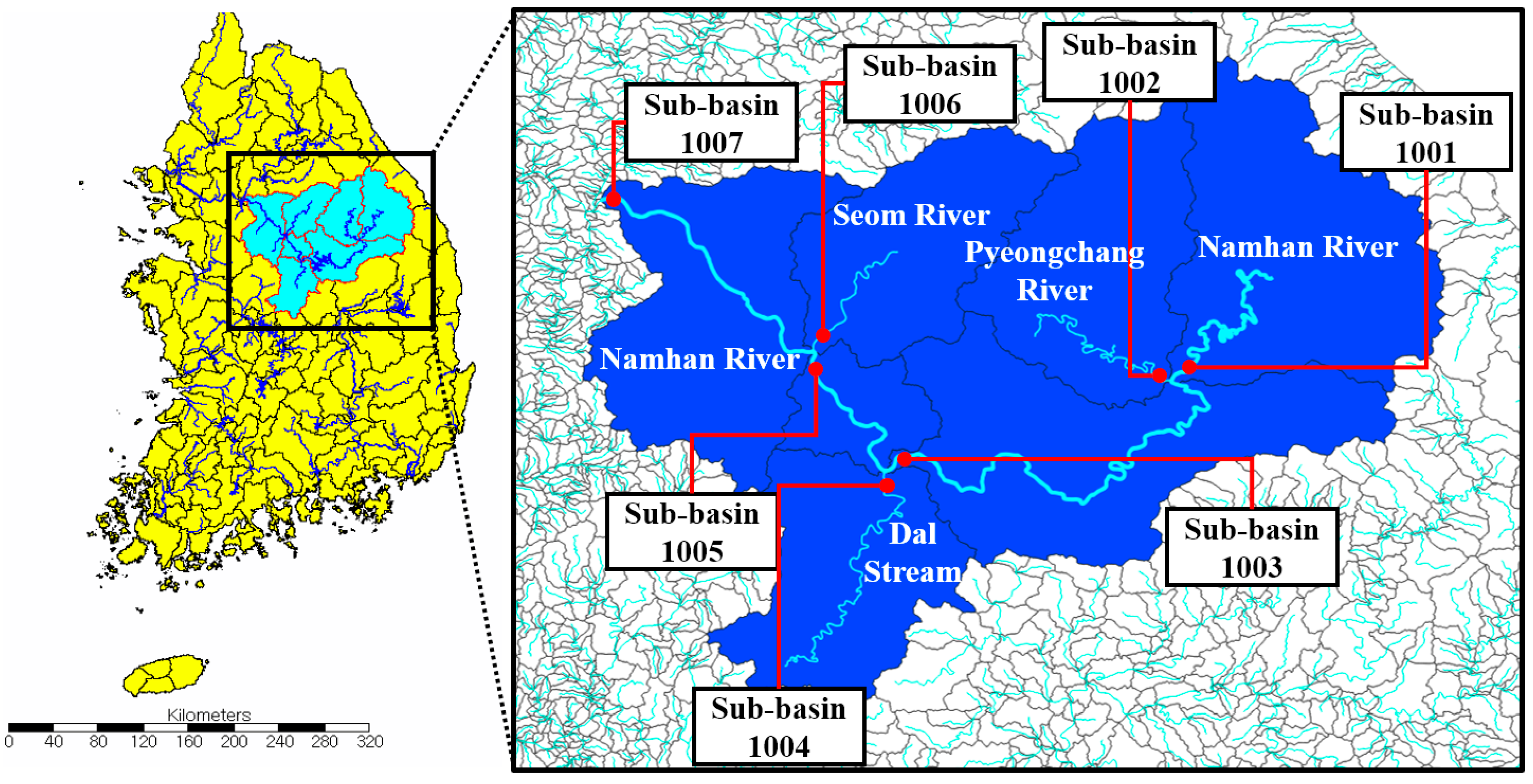
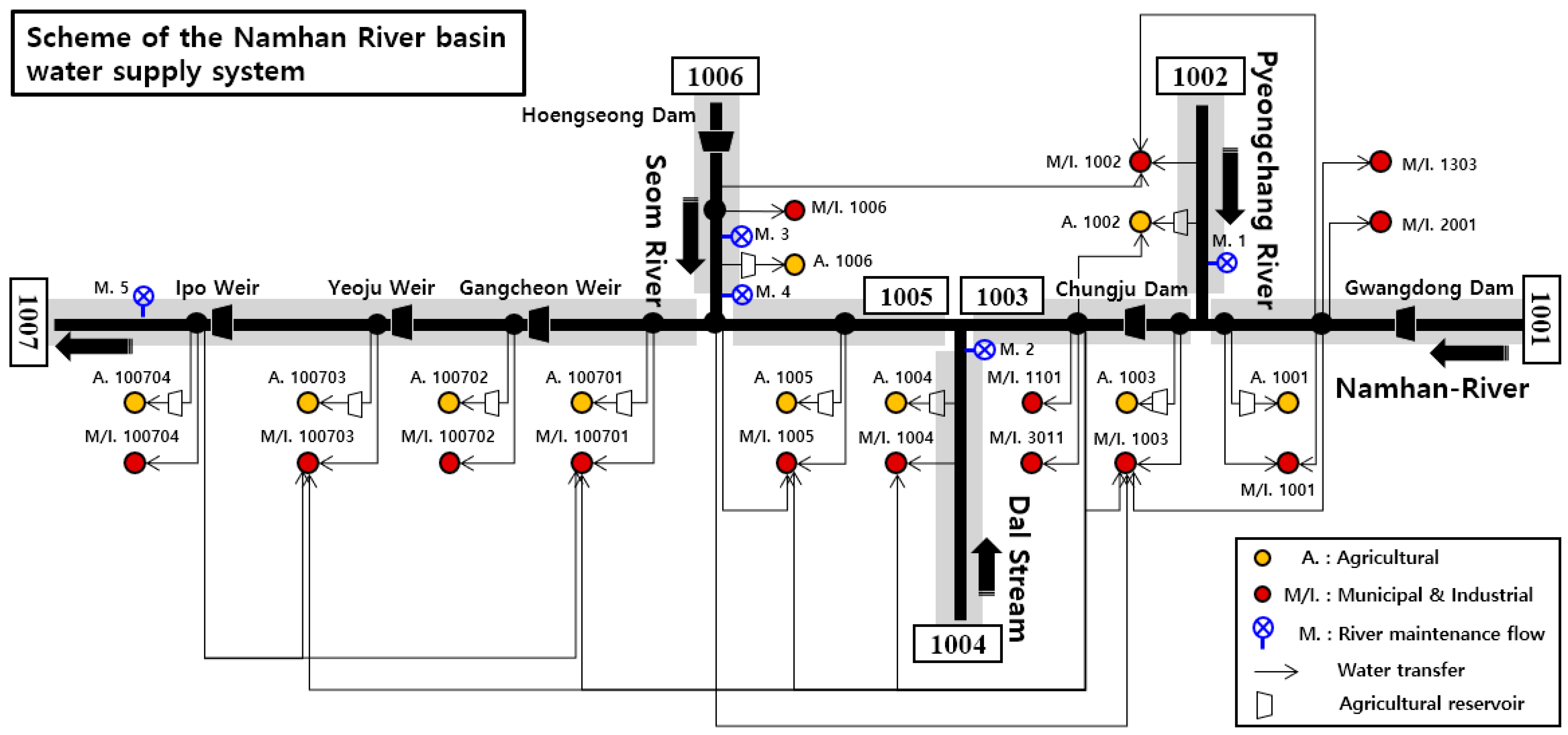

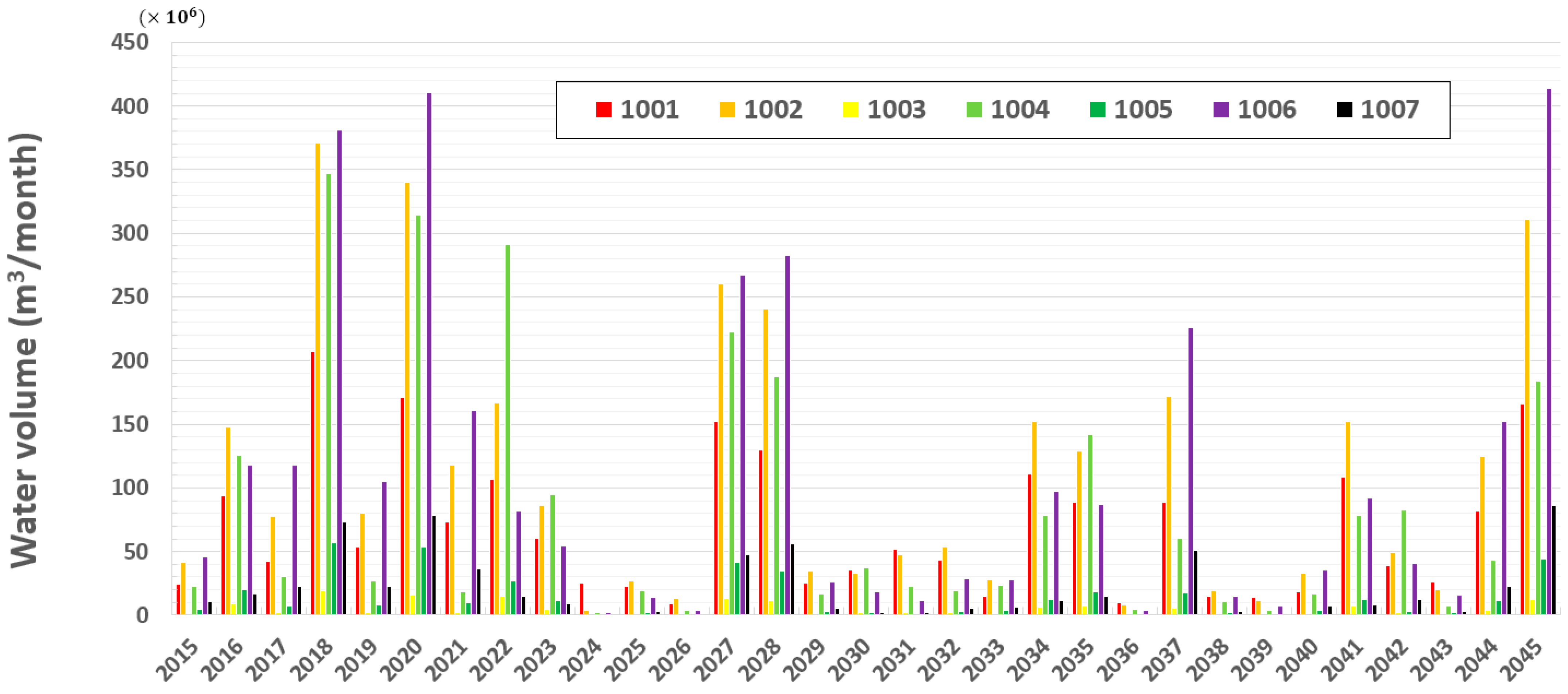
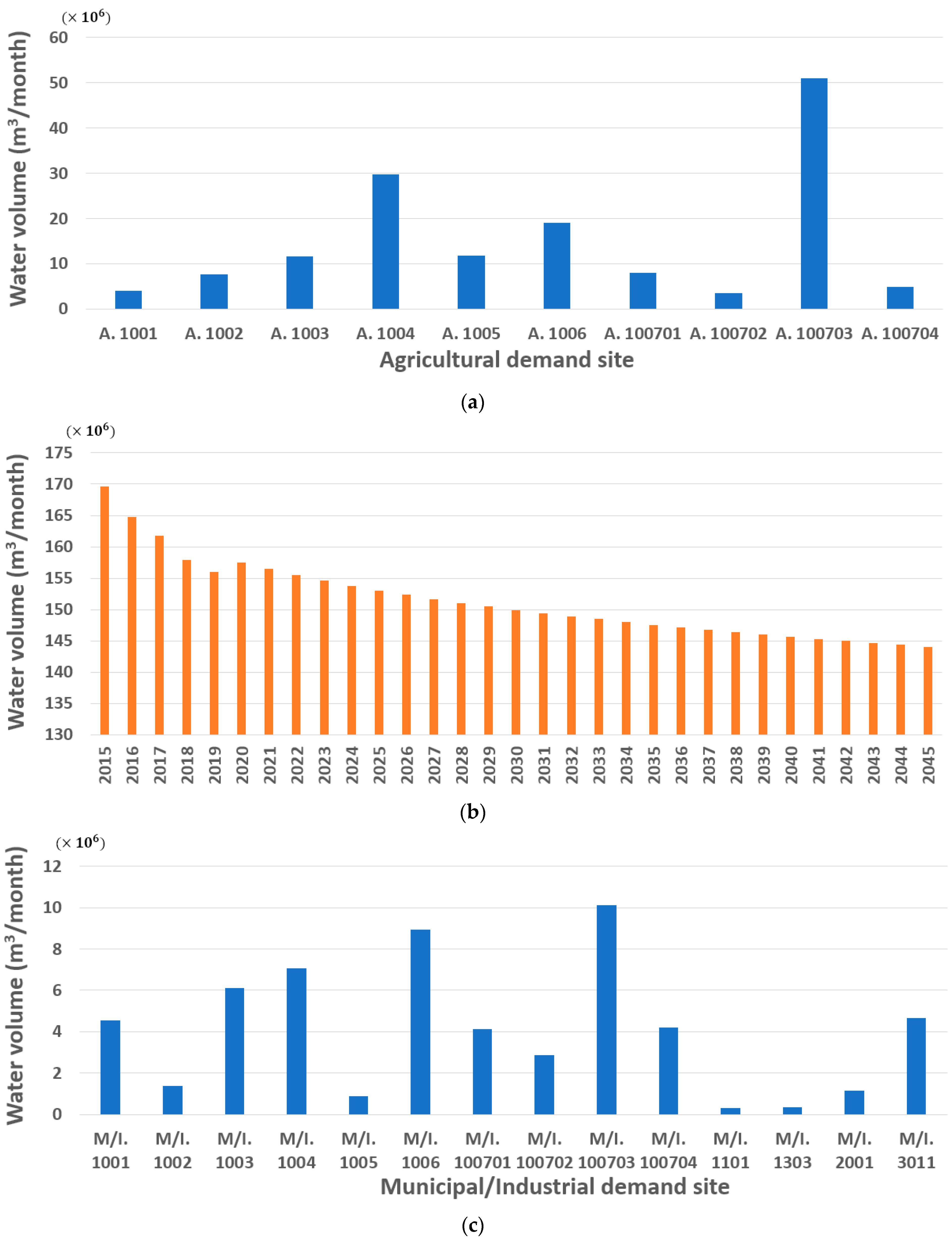

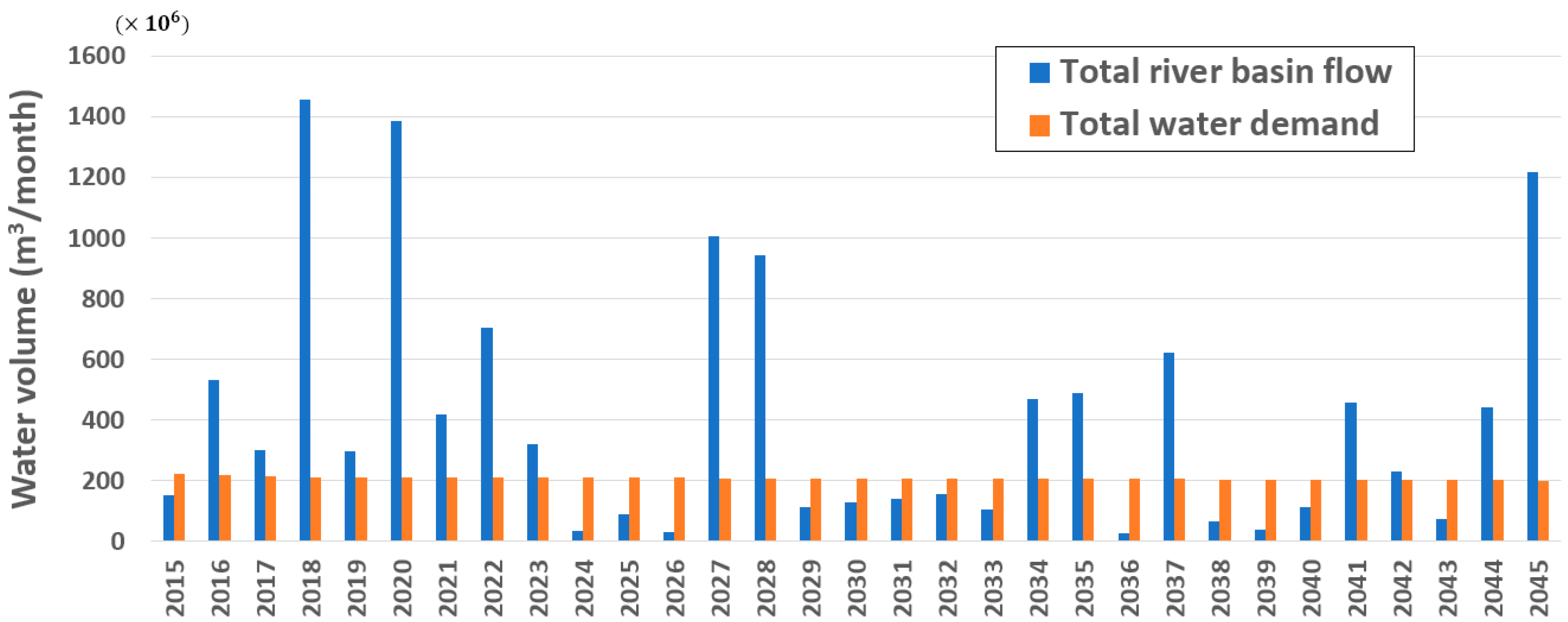
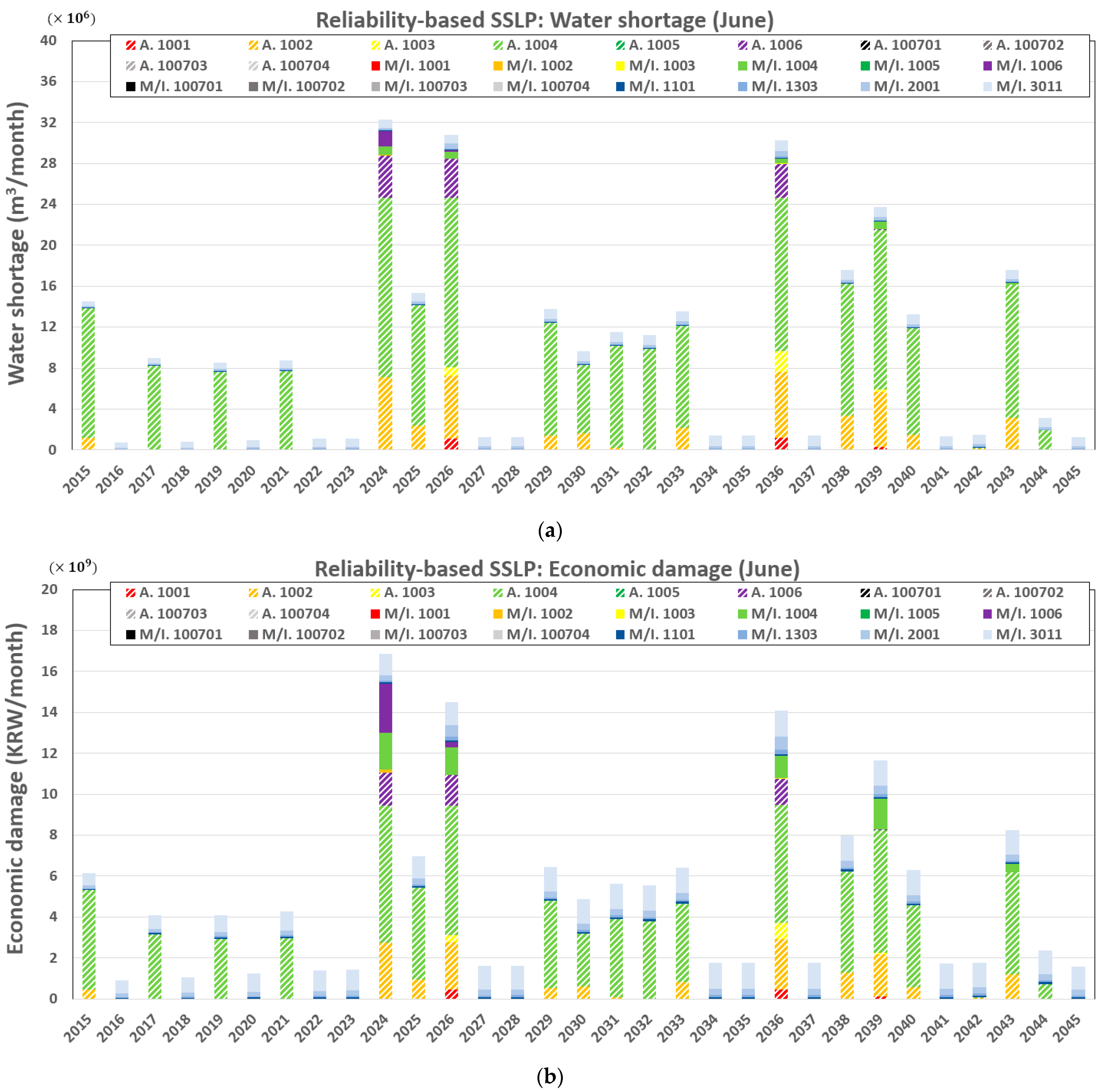
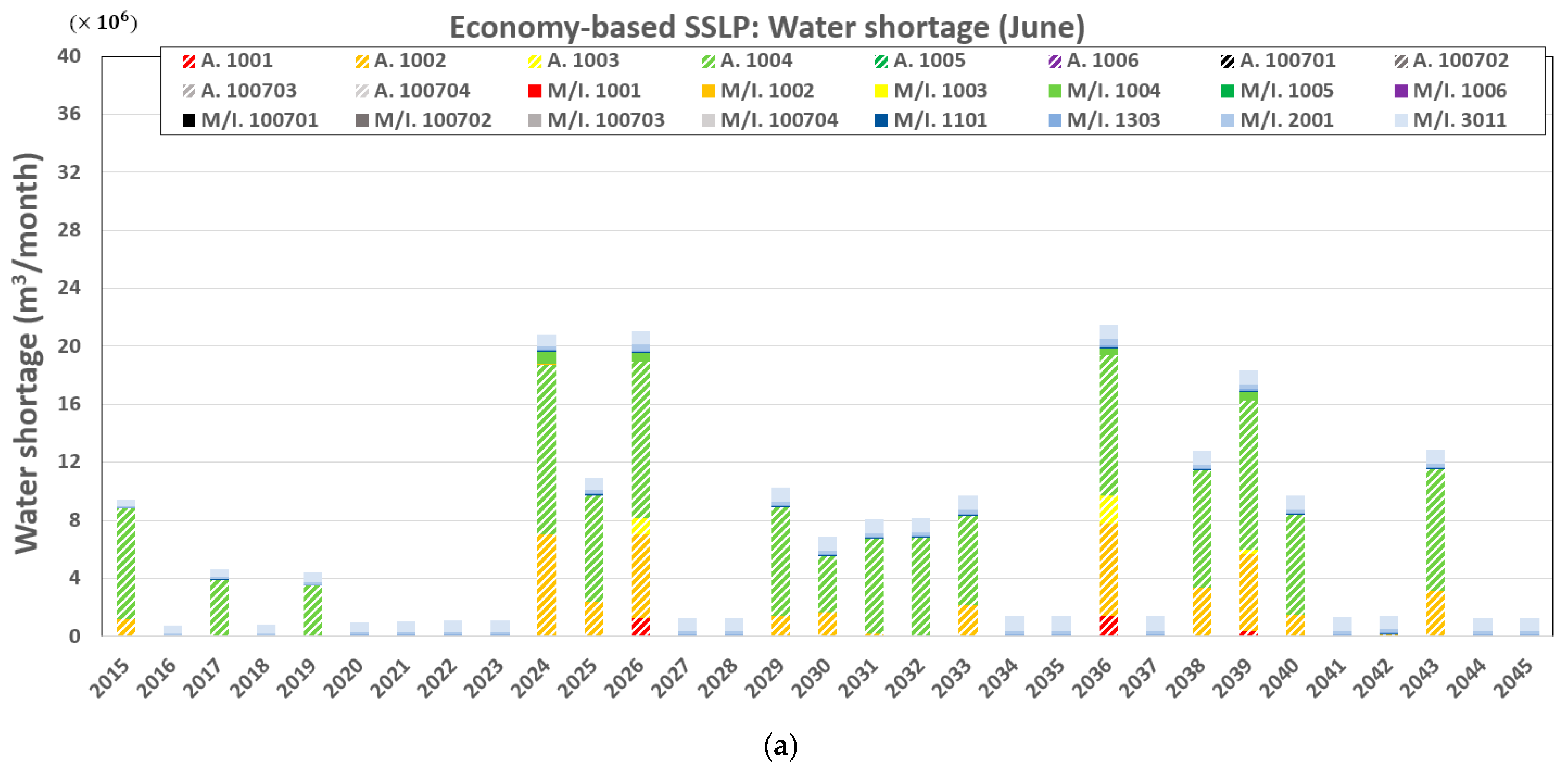


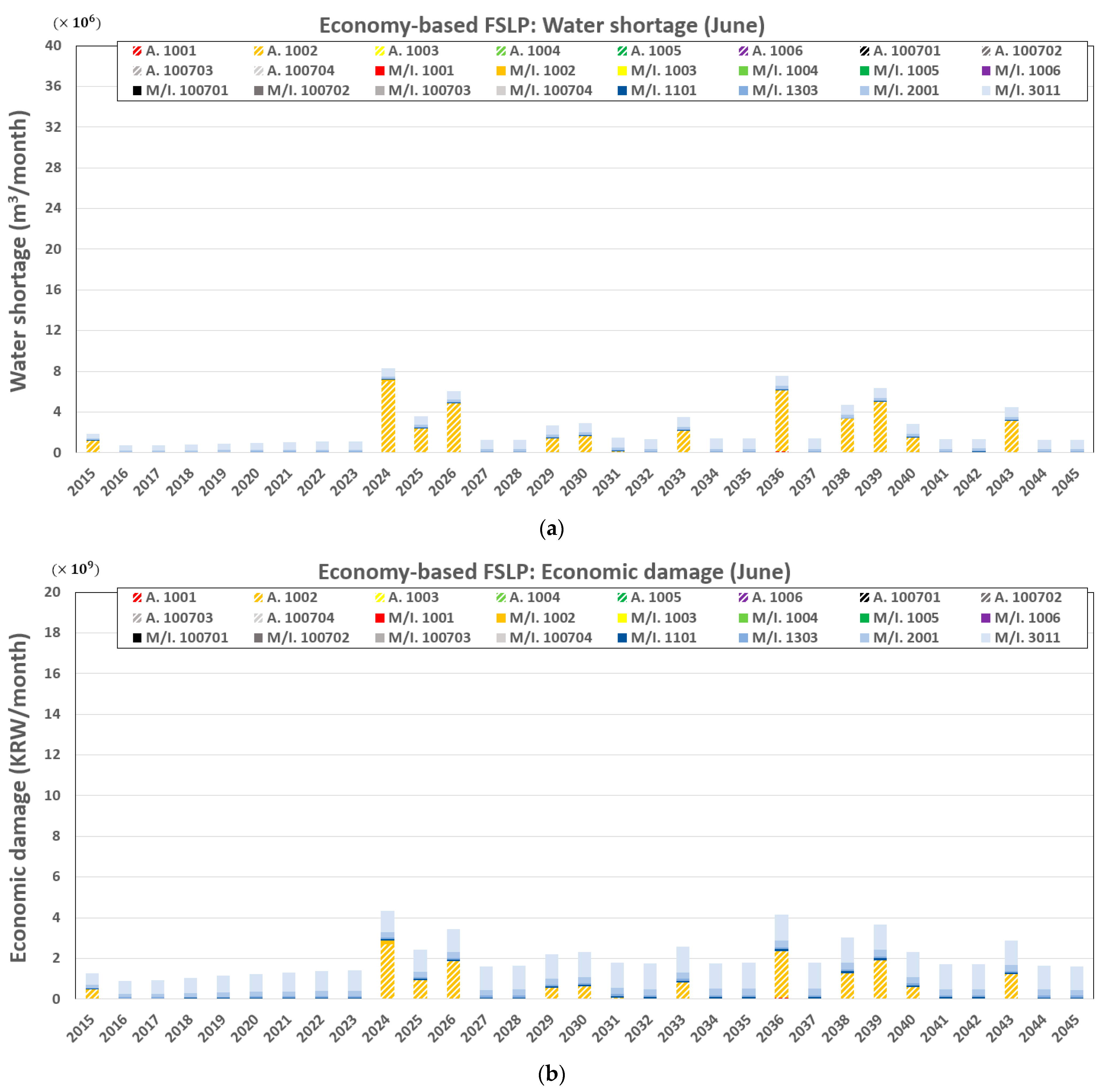
| Sub-Basin | Demand Sites | Water Demand (1000 m3) | Sub-Basin | Demand Sites | Water Demand (1000 m3) |
|---|---|---|---|---|---|
| External transmission | M/I. 1303 | 245 | 1005 | A. 1005 | 11,280 |
| M/I. 2001 | 780 | M/I. 1005 | 615 | ||
| M/I. 1101 | 225 | 1006 | A. 1006 | 18,559 | |
| M/I. 3011 | 3170 | M/I. 1006 | 6095 | ||
| 1001 | A. 1001 | 3900 | 1007 | A. 100701 | 7649 |
| M/I. 1001 | 3090 | M/I. 100701 | 2820 | ||
| 1002 | A. 1002 | 7361 | A. 100702 | 3318 | |
| M/I. 1002 | 955 | M/I. 100702 | 1960 | ||
| 1003 | A. 1003 | 11,227 | A. 100703 | 49,057 | |
| M/I. 1003 | 4175 | M/I. 100703 | 6880 | ||
| 1004 | A. 1004 | 28,585 | A. 100704 | 4584 | |
| M/I. 1004 | 4815 | M/I. 100704 | 2875 |
| Demand Site | Municipal Water Demand Ratio (%) | Industrial Water Demand Ratio (%) | Economic Value of Supply (KRW/m3) |
|---|---|---|---|
| M/I. 1001 | 38 | 62 | 3949 |
| M/I. 1002 | 92 | 8 | 1627 |
| M/I. 1003 | 69 | 31 | 2616 |
| M/I. 1004 | 80 | 20 | 2143 |
| M/I. 1005 | 63 | 37 | 2874 |
| M/I. 1006 | 92 | 8 | 1627 |
| M/I. 100701 | 61 | 39 | 2960 |
| M/I. 100702 | 61 | 39 | 2960 |
| M/I. 100703 | 61 | 39 | 2960 |
| M/I. 100704 | 61 | 39 | 2960 |
| M/I. 1101 | 100 | 0 | 1283 |
| M/I. 1303 | 100 | 0 | 1283 |
| M/I. 2001 | 100 | 0 | 1283 |
| M/I. 3011 | 100 | 0 | 1283 |
| Water Allocation Method |
Total Reliability | Average | Maximum | Minimum | |||
|---|---|---|---|---|---|---|---|
|
Water Shortage (106 m3/Month) |
Economic Damage (109 KRW/Month) |
Water Shortage (106 m3/Month) |
Economic Damage (109 KRW/Month) |
Water Shortage (106 m3/Month) |
Economic Damage (109 KRW/Month) | ||
| Reliability-based SSLP | 0.95 | 9.7 | 5.0 | 32.3 | 16.9 | 0.7 | 0.9 |
| Economy-based SSLP | 0.97 | 6.7 | 3.8 | 21.5 | 10.6 | 0.7 | 0.9 |
| Reliability-based FSLP | 0.99 | 2.5 | 2.03 | 8.3 | 4.38 | 0.7 | 0.9 |
| Economy-based FSLP | 0.99 | 2.5 | 2.02 | 8.3 | 4.36 | 0.7 | 0.9 |
Publisher’s Note: MDPI stays neutral with regard to jurisdictional claims in published maps and institutional affiliations. |
© 2021 by the authors. Licensee MDPI, Basel, Switzerland. This article is an open access article distributed under the terms and conditions of the Creative Commons Attribution (CC BY) license (https://creativecommons.org/licenses/by/4.0/).
Share and Cite
Jeong, G.; Kang, D. Hydro-Economic Water Allocation Model for Water Supply Risk Analysis: A Case Study of Namhan River Basin, South Korea. Sustainability 2021, 13, 6005. https://doi.org/10.3390/su13116005
Jeong G, Kang D. Hydro-Economic Water Allocation Model for Water Supply Risk Analysis: A Case Study of Namhan River Basin, South Korea. Sustainability. 2021; 13(11):6005. https://doi.org/10.3390/su13116005
Chicago/Turabian StyleJeong, Gimoon, and Doosun Kang. 2021. "Hydro-Economic Water Allocation Model for Water Supply Risk Analysis: A Case Study of Namhan River Basin, South Korea" Sustainability 13, no. 11: 6005. https://doi.org/10.3390/su13116005
APA StyleJeong, G., & Kang, D. (2021). Hydro-Economic Water Allocation Model for Water Supply Risk Analysis: A Case Study of Namhan River Basin, South Korea. Sustainability, 13(11), 6005. https://doi.org/10.3390/su13116005






